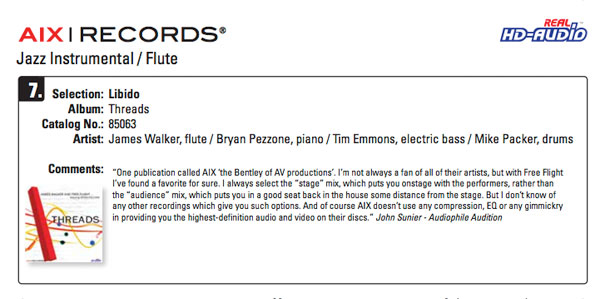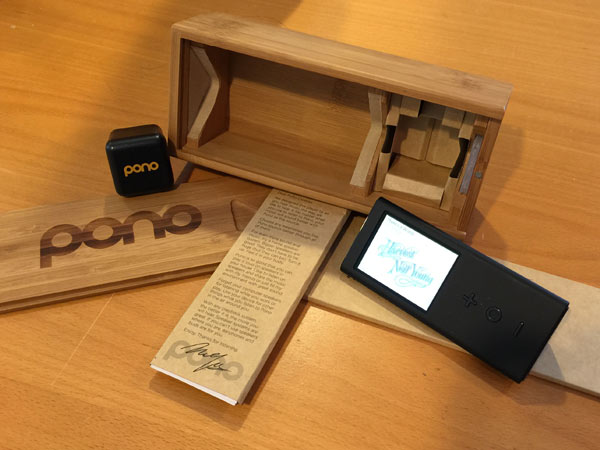A Few Things…
Pono Player Arrives
Guess what showed up in the UPS shipment yesterday? A Pono player! Don’t jump to any conclusions, I didn’t break down and purchase the device. A good friend asked if I would like to check it out. I told him sure. So a few days later, I have it sitting right next to me.
I feel like I should do one of those “unpacking” YouTube videos because I didn’t realize that it comes in a very nice wooden box. As a former woodworker, I can tell you that the box is a very elegant way to deliver a rather maligned audio player. There’s a sliding top complete with a small magnet to keep it from inadvertently opening and a little tray to anchor the triangular Pono player in place. I was almost expecting a velvet bag but I guess those are reserved for expensive power cords and interconnects.
I haven’t started to read the “Quick Start” guide but I’m anxious to get a few of my tracks on it and take a careful listen. Stay tuned coming soon.
Figure 1 – The Pono player and box.
Kudos
I received the following from a gentleman that was impressed with the free high-resolution tracks that I make available through my FTP site. If you haven’t had a chance to check them out, just fill out the form and hit submit.
“Dr AIX,
It took a while before I downloaded a couple of your sample tracks because I don’t feel I have a current set up that would let me hear High Res audio at its best. But since I have an open source app that can play the files, and a so-so DAC & amp connected to what I would call average speakers, I decided to give a listen and downloaded tracks 06, 07, and 08 [NOTE Latin Jazz Trio – Mujaka, James Walker and Free Flight – Libido, and Terry Trotter – The Kerry Dance].
WOW. The speakers seemed to just vanish and I had the feeling I was sitting in the middle of the band. The mix seemed perfectly flat…nothing sounded EQed (to bring out this or turn down that). Yet the presence of all the instruments is such that it is clear many microphones were used to capture the event. To pull that off, is an art, not to forget the science required.
Here is what I’m not clear on, this same mix played back at standard compact disc quality vs. the HD-Audio version would be missing what?
One additional question, on track 06 The Latin Jazz Trio at around 3:11 into the track a cymbal comes in, it sounds like a Zilgen, and I am wondering if that is correct, regardless, I have never heard a recorded cymbal sound so much like the real thing.
Also the piano on track 08 sounds like it is in the room with me. Amazing.
Ron”
Pretty nice to get such positive feedback.
MQA at Munich
Figure 2 – The Meridian area at the Munich Show…note Robert Harley and Robert Stuart at the table on the right.
I transcribed the pitch from the video presentation Meridian held at the Munich Show. I thought I would share it here because it mentions “provenance” (the term I contributed to the whole debate about high-res audio).
“MQA stands for Master Quality Authenticated. It means that in the studio, the artist can be sitting there in the studio with the producer and they can say, “this is my final master, this is my art, this is what I want everyone to hear. In fact, I want them to hear this exact sound. So now you’ve got a master quality file in a convenient, easy to use format that it is authentic and everyone knows. It takes away the arguments that have been going on over and over about the provenance of the files. Where did it come from? Was it upsampled? Is this the one that they really worked on? It now guarantees that you as the music lover, the music, fan are getting the exact file.”
I have a lot of questions regarding the claims made in this short speech. I think I’ll save them for a whole blog but consider this…we don’t have to worry about the provenance of a new recording, it’s the old ones in the new containers that are my concern.
See you tomorrow…




What do you mean “used to be a woodworker” ? That particular use of hands never stops. As soon as you smell the shop, you’ll be knee deep in shavings !
Anyway that Pono box should take the shape of what it really is, a Trojan Horse !
Related, just read some HIfi mag reviews and dismayed to see there are a few more “convert all to DSD” rollouts. The “me too” market with narcissistic attitude.
I would love to have a shop again. I cut dovetails, built furniture, puzzles etc but it was 30 years ago. I would be curious to hear about companies other than PS Audio that are mandating conversion to DSD. It’s hard to believe that people are falling for this crap.
When you fire up the Pono be sure to try the balanced mode. Looking forward to your thoughts..
I will…although it may have to wait until after the Newport Show.
Man this blog is getting like a daytime TV soap opera, you left us with at least 3 cliffhangers today. 🙂
I have no issue with the Pono player, it’s just one of several HD capable portable players on the market. If it sounds half as good as the competition that’s priced at 2-3 times its cost, kool.
It’s their music store and their claims of HD files from SD sources that’s deceptive.
Will tune in tomorrow for the next episode of Days of Our HD Lives. Lol
Thanks Sal…
I believe the Pono player box is made from bamboo. Please do set the player to balanced playback mode and give a listen.
I do just the opposite. I convert all my DSD files to PCM for playback.
Same here. Because I need to “subtract” the room influence from the actual in-room-response at the listening position or else I’d not able to listen to the content as it was intended by the artist. It’s simply because of the fact that even the most linear speakers put in a room, are not going to be flat at all. The room is the biggest contributer to colorations of what we hear and its influence is magnitudes higher than anything we see from preamps, power amps, cables and what have you (+/- 10 dB).
So I consider it kind of mandatory to “counter” my room via room equalization. I use DIRAC to apply this room correction to all my playback and it’s excellent. However, for SACDs this requires a DSD-to-PCM conversion beforehand as the correction filters applied by the DSPs can only work on PCM signals.